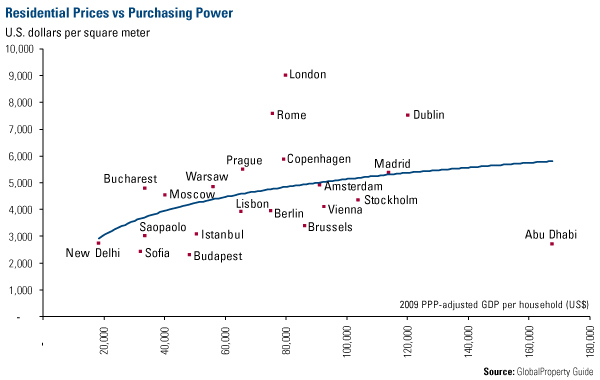This week’s chart plots the residential prices of major cities around the world against the purchasing power of the people living there. In terms of affordability, the upper left quadrant is where you don’t want to be. That means that the cost for housing is high while the average income per household is low.
What about the lower right quadrant? Abu Dhabi is the outlier there because it has the third-highest GDP per capita in the world behind Luxembourg and Norway but residential prices remain low. This can be both a good and bad quality. On the one hand, Abu Dhabi has a very wealthy population which reflects the city’s economic vitality. On the other hand, residential prices are still showing the effects of the 2008 crash when prices for higher-end apartments and homes fell 35 percent in just three months.

The ideal place to be is right in the center, striking a balance between residential prices and incomes.
Two cities that are moving toward the center, though at different speeds, are Moscow and Istanbul. Residential real estate in both Russia and Turkey stands to benefit from historically low interest rates, recovering unemployment and improving consumer confidence, according to Merrill Lynch.
In Turkey, the strength of the recovery has resulted in record auto sales, growth in mortgage loans and restored consumer confidence, Merrill Lynch says. Recently, this strength has raised inflation concerns but there are several pillars to support the residential market.
Demand from the young and growing middle class is jumping as developers have begun offering smaller units, banks are offering longer loan durations and interest rates are at an all-time low. As a result, mortgage loans have grown 32 percent so far this year and are estimated to grow an additional 30 percent in 2011.
If you need more evidence, just look at what happened yesterday when property developer Emlak’s initial public offering jumped 12 percent in its first day of trading and another 11 percent in early trading today. We were fortunate to participate in this offering in our Eastern European Fund (EUROX); adding Emlak to the fund’s existing weighting in Turkey. Emlak isn’t the first Turkish company looking to tap into Turkey’s potential growth. Six Turkish real estate investment trusts have already sold shares to the public this year, according to Bloomberg.
Though the Russian economy has recovered, it is not nearly as far along as Turkey. Affordability is an issue in Russia. Official statistics show only 20 percent of the population can afford their mortgage payments at the moment, but the expectation is that this will extend an additional 20 percent in the next five years.
Banks are using government subsidies as a crutch and have been reluctant to hand out mortgages not backed by the government, but the market could heat up quickly once more mortgages are released into the system. Russia is currently under-levered in terms of debt compared to its Central Emerging European peers, which means there is ample catch-up potential when consumer confidence returns.
Long term, the trend for both residential markets looks positive. Low mortgage penetration in both markets means there is room to grow if inflation can remain under control.
Please consider carefully a fund’s investment objectives, risks, charges and expenses. For this and other important information, obtain a fund prospectus by visiting www.usfunds.com or by calling 1-800-US-FUNDS (1-800-873-8637). Read it carefully before investing. Distributed by U.S. Global Brokerage, Inc.
Foreign and emerging market investing involves special risks such as currency fluctuation and less public disclosure, as well as economic and political risk.
By investing in a specific geographic region, a regional fund’s returns and share price may be more volatile than those of a less concentrated portfolio.
The Eastern European Fund invests more than 25% of its investments in companies principally engaged in the oil & gas or banking industries. The risk of concentrating investments in this group of industries will make the fund more susceptible to risk in these industries than funds which do not concentrate their investments in an industry and may make the fund’s performance more volatile.
Holdings in the Eastern European Fund as a percentage of net assets as of September 30, 2010: Emlak 0.00%.